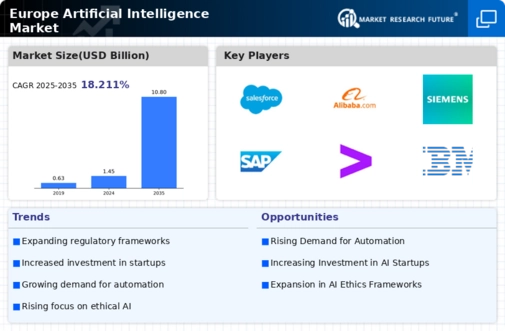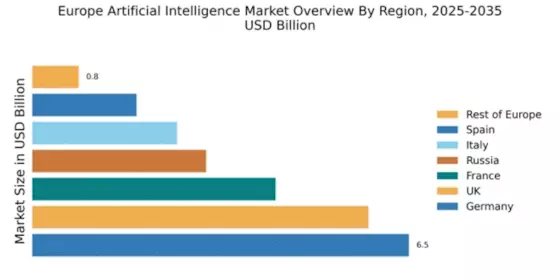Increased Data Availability
The availability of vast amounts of data is a pivotal driver for the artificial intelligence market. With the proliferation of digital technologies, organizations are generating and collecting unprecedented volumes of data. This data serves as the foundation for training AI models, enabling more accurate predictions and insights. According to estimates, the data generated in Europe is expected to reach 35 zettabytes by 2025, providing a rich resource for AI applications. As businesses recognize the value of data-driven decision-making, they are increasingly investing in AI solutions to harness this potential. Consequently, the increased availability of data significantly enhances the capabilities of AI technologies, driving growth in the artificial intelligence market in Europe.
Rising Demand for Automation
The artificial intelligence market in Europe experiences a notable surge in demand for automation across various sectors. Industries such as manufacturing, logistics, and healthcare are increasingly adopting AI technologies to enhance operational efficiency and reduce costs. According to recent data, the automation market is projected to grow at a CAGR of 25% from 2023 to 2028, indicating a robust appetite for AI-driven solutions. This trend is driven by the need for businesses to streamline processes and improve productivity. As organizations seek to remain competitive, the integration of AI into their operations becomes essential. Consequently, the rising demand for automation significantly propels the growth of the artificial intelligence market, as companies invest in innovative technologies to meet evolving consumer expectations.
Advancements in AI Technologies
Technological advancements are a key driver of the artificial intelligence market. Innovations in machine learning, natural language processing, and computer vision are enabling the development of more sophisticated AI applications. For instance, breakthroughs in deep learning algorithms have significantly improved the accuracy of AI systems, making them more applicable across various industries. The European AI market is projected to reach €100 billion by 2025, driven by these technological advancements. As companies seek to leverage cutting-edge AI technologies, they are increasingly investing in research and development. This focus on innovation not only enhances the capabilities of AI solutions but also fosters competition among market players. Therefore, advancements in AI technologies are instrumental in propelling the growth of the artificial intelligence market in Europe.
Government Initiatives and Funding
Government initiatives play a crucial role in shaping the artificial intelligence market. Various European nations are implementing strategic plans to foster AI development, including funding programs and research grants. For instance, the European Commission has allocated €1.5 billion to support AI research and innovation from 2021 to 2027. Such investments aim to enhance the region's competitiveness in the global AI landscape. Additionally, national governments are establishing AI-focused policies to encourage collaboration between academia and industry. These initiatives not only stimulate innovation but also create a favorable environment for startups and established companies alike. As a result, government support is a significant driver of growth in the artificial intelligence market in Europe, facilitating advancements in technology and application.
Growing Focus on AI Ethics and Regulation
The artificial intelligence market in Europe is witnessing a growing emphasis on ethics and regulation. As AI technologies become more pervasive, concerns regarding privacy, bias, and accountability have emerged. European regulators are actively working on frameworks to ensure responsible AI development and deployment. The proposed AI Act aims to establish guidelines for high-risk AI applications, promoting transparency and fairness. This regulatory landscape encourages companies to prioritize ethical considerations in their AI strategies. By fostering trust among consumers and stakeholders, the focus on AI ethics is likely to enhance the adoption of AI solutions. Thus, the growing focus on ethics and regulation serves as a critical driver for the artificial intelligence market, shaping its future trajectory.


















Leave a Comment